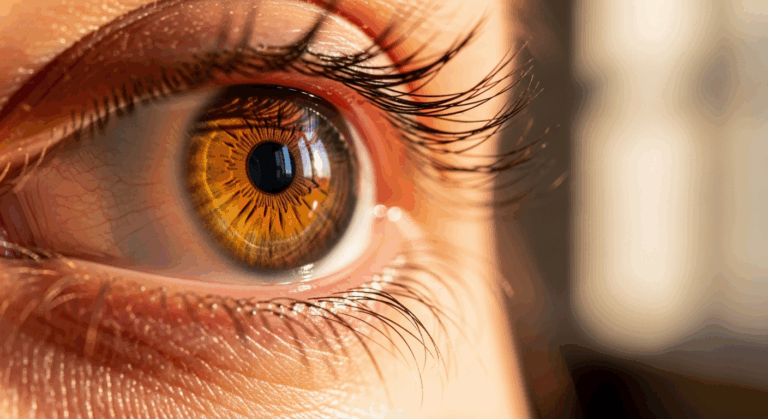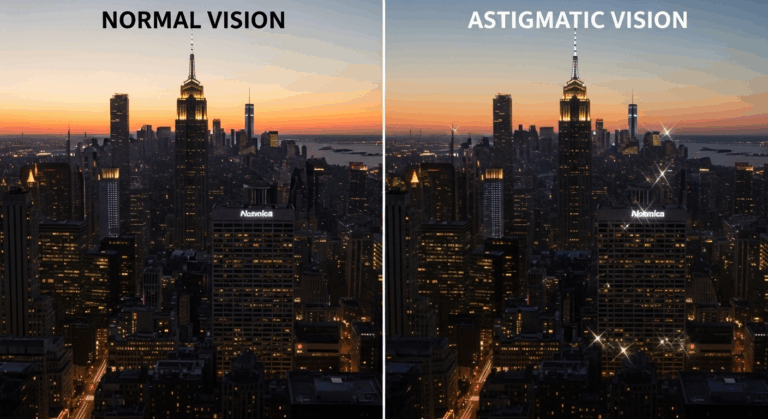Single vision glasses are the simplest, most common type of prescription eyewear — but “simple” doesn’t mean unimportant. If you’ve ever squinted to read your phone or leaned in to see a menu, chances are a pair of single vision lenses could help. In this guide I’ll walk you through what single vision glasses are, how they differ from other lens types, who benefits most, and practical tips from optometry for buying and wearing them.
We often get asked: “So are single vision lenses just for reading?” Short answer: sometimes — but they’re also used for distance, intermediate, or any one prescription power you need across the whole lens. Think of them as a single, consistent prescription across the entire lens surface — like a single song on repeat, not a mixtape.
What Are Single Vision Glasses?
Single vision glasses have one focal power across the entire lens. That means the whole lens corrects for one visual need — distance, near (reading), or intermediate (computer) — rather than multiple needs in the same lens.
Single vision vs. multifocal lenses
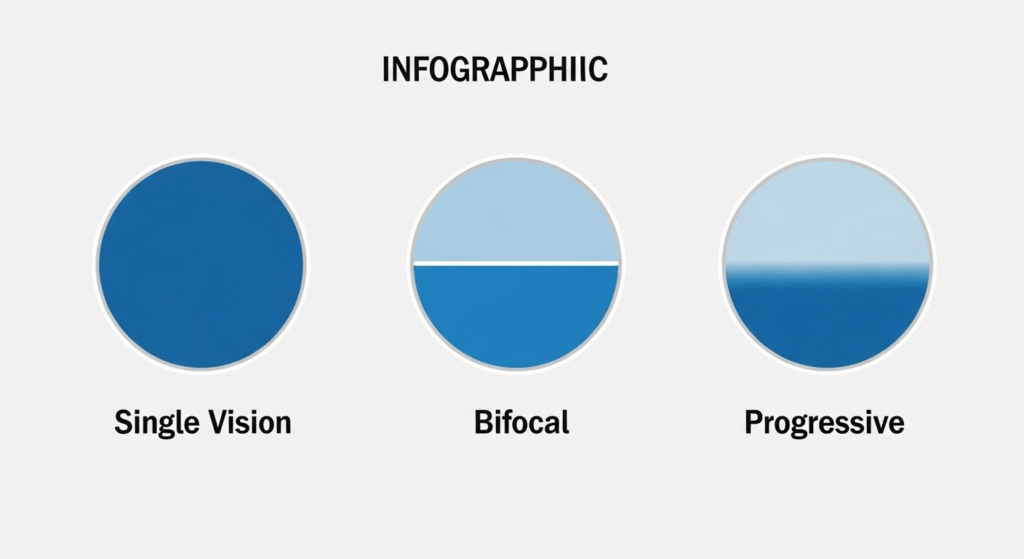
- Single vision lenses: One power everywhere. Great if you need correction for only one range of vision.
- Bifocals: Two distinct zones — usually distance and near — separated by a visible line.
- Progressives (multifocals): Smooth, gradual change between distance, intermediate, and near without visible lines.
Imagine your vision needs as a staircase: bifocals give you two steps, progressives give you a ramp. Single vision? It’s one solid step — stable and predictable.
Who Should Wear Single Vision Lenses?
Single vision glasses are ideal for a lot of people. Here are common scenarios:

Myopia (nearsightedness)
If you can’t see distance clearly — road signs, movie screens — you’ll usually get single vision lenses for distance vision.
Hyperopia (farsightedness) and presbyopia
You might use single vision lenses for near tasks (reading glasses) if you only need help up close. However, as presbyopia progresses (usually after 40), many people switch to progressives or reading glasses depending on lifestyle.
Astigmatism
Yes — single vision lenses can correct astigmatism by including the necessary cylindrical power and axis in the single prescription.
Children and single prescriptions
Kids with myopia are commonly fitted with single vision distance lenses. (We often promote regular eye checks because children’s prescriptions can change quickly.)
How Single Vision Glasses Are Prescribed and Measured
Getting an accurate prescription and fit matters — a lot.
The eye exam/prescription
An optometrist or ophthalmologist measures your refractive error and writes a prescription (sphere, cylinder, axis). For single vision lenses, the prescription formula applies to the whole lens.
Pupillary distance (PD)
PD is the horizontal distance between your pupils. If the optical center of the lens doesn’t line up with your pupils, you might get headaches or blurred vision. Remember this when ordering glasses online — always enter a correct PD.
Lens material and index
Different materials bend light differently. Common choices:
- CR-39 (standard index): Lightweight, affordable.
- Polycarbonate: Impact-resistant — good for kids and sports.
- High-index: Thinner and lighter for stronger prescriptions.
We recommend discussing lifestyle and prescription strength with your doctor when choosing material.
Lens Coatings, Treatments, and Add-Ons
Single vision lenses can have the same coatings and treatments as other lenses.
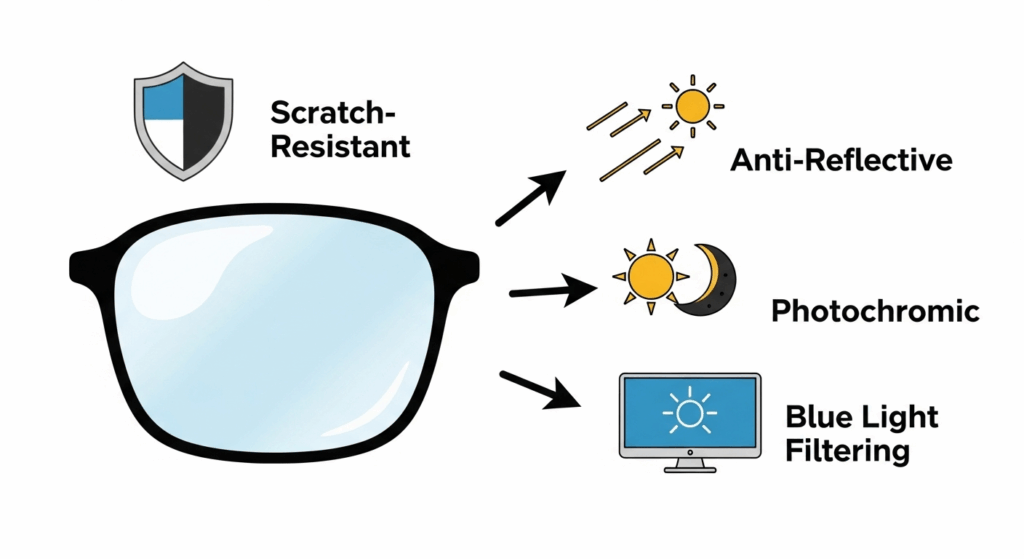
Anti-reflective (AR) coating
Reduces glare from screens and headlights; it makes lenses look clearer (no “mirror” effect).
Scratch-resistant coating
No lens is scratch-proof, but this coating helps extend life.
Blue light filtering
Some people prefer blue light filters for heavy screen time. Evidence on long-term eye protection is mixed, but users often report reduced eye strain.
Photochromic lenses
Also called transition lenses — they darken in sunlight and remain clear indoors. A convenient option if you want single-vision correction that adapts outdoors.
Advantages and Limitations
Advantages
- Simplicity: No learning curve like progressives.
- Cost-effective: Usually cheaper than multifocal lenses.
- Ideal for single-task needs: E.g., strictly distance driving or only reading.
Limitations
- One task at a time: If you need both distance and reading correction in daily life, you may need multiple pairs or multifocal lenses.
- Not ideal for progressive age-related vision changes: Presbyopic patients often prefer multifocals or separate reading glasses.
Think of single vision glasses like a specialty tool — excellent when used for the right job, but not a one-size-fits-all solution.
Practical Tips for Choosing Single Vision Glasses
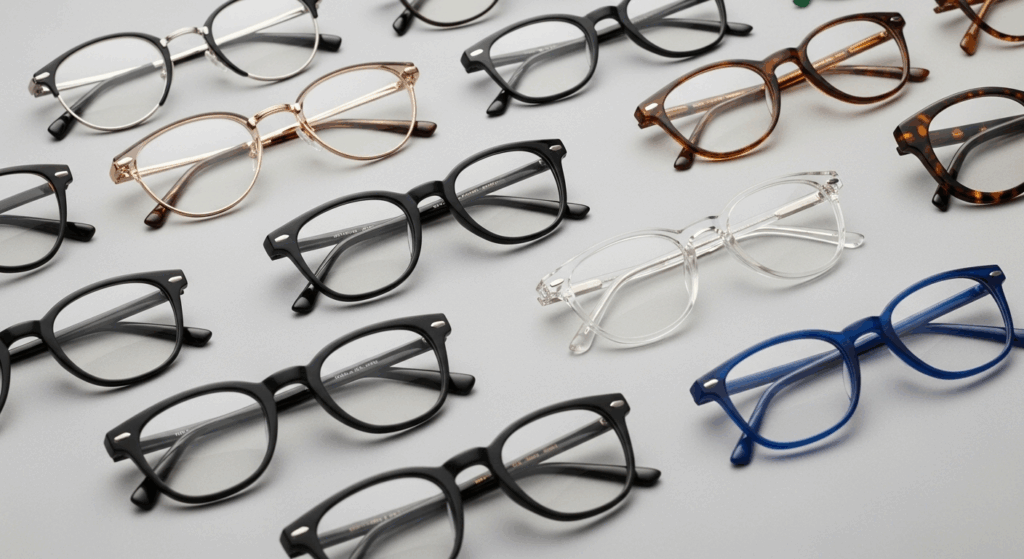
Match lens to the task
Decide whether you need distance, near, or intermediate correction most of the time. If your job is computer-heavy, intermediate-focused single vision (computer glasses) might be perfect.
Frame choice matters
Larger frames let labs place optical centers more accurately and give more usable lens area for certain tasks. But smaller frames can be lighter and more stylish — balance form and function.
Consider backup pairs
If you use single vision distance glasses and need to read a lot, keep a pair of reading glasses handy. It’s cheaper (and sometimes more comfortable) than buying multifocals if your near and distance needs are separate.
Ask about adjustments
A good optician will adjust frame fit so the lenses line up with your pupils and ensure comfort. Don’t skip this step; it makes a big difference.
Cost and Insurance — What to Expect
Prices vary widely depending on lens material, coatings, and frame brands. Single vision lenses are typically the most economical option among prescription lenses. If you have vision insurance, it often covers part of an exam and a standard pair of single vision lenses every 12–24 months — check your plan.
Final Thoughts — Is Single Vision Right for You?
If you need correction for one visual distance and want a straightforward, cost-effective solution, single vision glasses are probably your best bet. They’re predictable, comfortable, and customizable with coatings and materials to match your lifestyle.
We often tell patients: “Start simple.” If your day-to-day life changes — for example you start needing both reading and distance correction — you can always explore progressives or keep a second pair for specific tasks. Remember, the best glasses are the ones you’ll actually wear.

